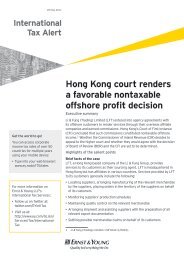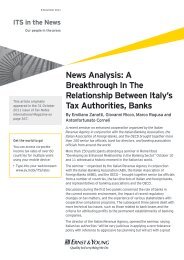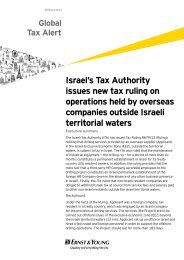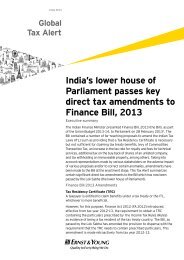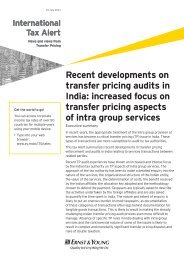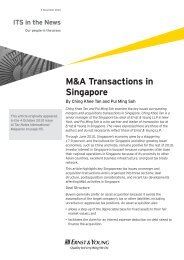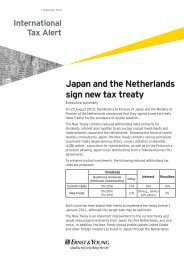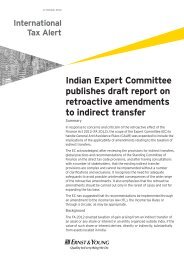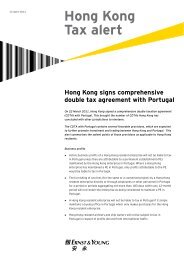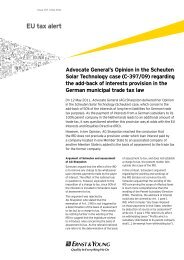Download - Ernst & Young T Magazine
Download - Ernst & Young T Magazine
Download - Ernst & Young T Magazine
You also want an ePaper? Increase the reach of your titles
YUMPU automatically turns print PDFs into web optimized ePapers that Google loves.
Feature The global executive Credit: Jos Schmid<br />
From expat manager<br />
to global executive<br />
Despatching old hands from head office to run the show in new territories has<br />
been a feature of international business. But a competitive, globalized marketplace<br />
is reshaping the nature and dynamics of the expatriate assignment.<br />
Summary<br />
The traditional<br />
expatriate model is<br />
changing as companies<br />
get to grips with a<br />
changing global<br />
economy. Executives • By Paul Kielstra<br />
are not just flowing from<br />
West to East, but in all Viewed through a narrow lens,<br />
directions. Overseas<br />
the traditional corporate expat<br />
postings can be a<br />
seems alive and well. Cost<br />
powerful tool to share cutting during the recent downturn<br />
expertise and build dented the enthusiasm of companies<br />
leadership talent, but for sending people abroad, but now<br />
there are many<br />
firms are stepping up the number of<br />
practical difficulties such assignments.<br />
that can impede their <strong>Ernst</strong> & <strong>Young</strong>’s recent Global<br />
success.<br />
Mobility Effectiveness Survey found<br />
that, although the number of<br />
companies with at least 1% of<br />
employees on a short-term international<br />
assignment declined precipitously from 48% in<br />
2008 to just 20% in 2010, it bounced back up to<br />
33% during 2011. Longer-term assignments,<br />
which are harder to cut rapidly, never went out<br />
of fashion: the proportion of businesses with<br />
more than 1% of employees on long-term<br />
postings rose steadily from 27% in 2008 to 46%<br />
in 2011.<br />
In line with the rebalancing of the global<br />
economy toward high-growth emerging markets,<br />
these are the primary destinations for expatriate<br />
postings. About six in 10 (61%) of companies<br />
polled have seen an increase in the number of<br />
international transfers to emerging growth<br />
markets in the last three years. Nearly seven in<br />
ten (68%) expect to see a further rise in the next<br />
three years. Other studies back this up. A 2010<br />
Economist Intelligence Unit (EIU) survey<br />
indicated that by far the most international<br />
transfers still originate from Western Europe and<br />
North America, with China and the rest of Asia<br />
the most common destinations. The key drivers<br />
for such assignments are strategic and<br />
managerial needs. In the EIU’s words, “The<br />
traditional expat model is alive and well”.<br />
New patterns of postings<br />
But all this misses some significant changes. The<br />
most obvious is the evolving traffic patterns of<br />
executives. Philippe Waty, Group Head of<br />
Compensation and Benefits at Novartis, the<br />
Swiss-based global pharmaceutical company, has<br />
seen a “rapid change with respect to executives<br />
moving out of developing countries, with many<br />
people from India and China coming to<br />
developed countries over the last few years.”<br />
Others agree. Susan Steele, Global Chief Human<br />
Resources Officer at Millward Brown, a global<br />
brand insight consultancy, explains that, “In the<br />
past, it was one-way traffic from the United<br />
States and Europe to the rest of the world. Now,<br />
in sending people to Africa, we are taking folks<br />
from India and vice versa. It is becoming much<br />
more blended and less one-way. Going on<br />
assignment will be the norm for this current<br />
8 T <strong>Magazine</strong> Issue 07 <strong>Ernst</strong> & <strong>Young</strong>



